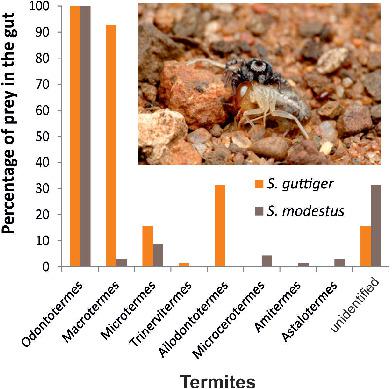当前位置:
X-MOL 学术
›
Ecol. Entomol.
›
论文详情
Our official English website, www.x-mol.net, welcomes your feedback! (Note: you will need to create a separate account there.)
Coexistence of two termite-eating specialists (Araneae)
Ecological Entomology ( IF 2.2 ) Pub Date : 2020-07-17 , DOI: 10.1111/een.12914 Stano Pekár 1 , Lenka Petráková Dušátková 1 , Ondřej Michálek 1 , Charles R. Haddad 2
Ecological Entomology ( IF 2.2 ) Pub Date : 2020-07-17 , DOI: 10.1111/een.12914 Stano Pekár 1 , Lenka Petráková Dušátková 1 , Ondřej Michálek 1 , Charles R. Haddad 2
Affiliation

|
Competition among closely‐related specialist predators has rarely been studied, and thus the mechanism of their coexistence remains enigmatic. Interspecific competition among specialised co‐occurring predators capturing termites should be high. Here we investigated various niche dimensions, namely temporal, spatial and trophic, of a couple of jumping spider species of the genus Stenaelurillus (Stenaelurillus guttiger and S. modestus) from South Africa, to find whether these two species co‐exist and along which niche dimension(s) they differentiate. The two species co‐occurred in two out of five study sites. Body size was not significantly different between the species. The phenology was shifted so that one species matured earlier. Circadian activity was not different, as both species were diurnal and active at similar times. Both species preyed almost exclusively on termites. The fundamental trophic niche was very similar and rather narrow. The realised trophic niche at the prey order level of both species was similar, but at the genus level it was different. In S. modestus it was narrower, as it captured mainly Odontotermes, while S. guttiger exploited a few termite species. The size of prey captured was also similar between the two species. The frequency of intraguild predation was negligible. We conclude that both Stenaelurillus species are specialised termitophagous predators. The two species can coexist across broad spatial scales due to spatial segregation on the landscape. At the sites where they co‐occur, the two species specialise on different termite prey, promoting local coexistence.
中文翻译:

两个吃白蚁的专家(Araneae)共存
很少研究密切相关的专业捕食者之间的竞争,因此它们共存的机制仍然是个谜。专门捕获白蚁的共生捕食者之间的种间竞争应该很高。在这里,我们调查了来自南非的 Stenaelurillus 属(Stenaelurillus guttiger 和 S. normus)的几种跳蛛的各种生态位维度,即时间、空间和营养,以找出这两个物种是否共存以及沿着哪个生态位他们区分的维度。这两个物种同时出现在五个研究地点中的两个。体型在物种之间没有显着差异。物候发生了变化,因此一个物种成熟得更早。昼夜节律活动没有什么不同,因为这两个物种都是昼夜活动,并且在相似的时间活跃。这两个物种几乎都以白蚁为食。基本的营养生态位非常相似而且相当狭窄。两种物种在猎物级水平上实现的营养生态位相似,但在属级水平上则不同。在 S. normus 中它更窄,因为它主要捕获 Odontotermes,而 S. guttiger 则利用了一些白蚁物种。这两个物种捕获的猎物的大小也相似。公会内捕食的频率可以忽略不计。我们得出结论,这两种 Stenaelurillus 物种都是专门的食白蚁掠食者。由于景观上的空间隔离,这两个物种可以在广泛的空间尺度上共存。在它们共同出现的地点,这两个物种专门捕食不同的白蚁,促进了当地的共存。基本的营养生态位非常相似而且相当狭窄。两种物种在猎物级水平上实现的营养生态位相似,但在属级水平上则不同。在 S. normus 中它更窄,因为它主要捕获 Odontotermes,而 S. guttiger 则利用了一些白蚁物种。这两个物种捕获的猎物的大小也相似。公会内捕食的频率可以忽略不计。我们得出结论,这两种 Stenaelurillus 物种都是专门的食白蚁掠食者。由于景观上的空间隔离,这两个物种可以在广泛的空间尺度上共存。在它们共同出现的地点,这两个物种专门捕食不同的白蚁,促进了当地的共存。基本的营养生态位非常相似而且相当狭窄。两种物种在猎物级水平上实现的营养生态位相似,但在属级水平上则不同。在 S. modernus 中,它更窄,因为它主要捕获 Odontotermes,而 S. guttiger 则利用了一些白蚁物种。这两个物种捕获的猎物的大小也相似。公会内捕食的频率可以忽略不计。我们得出结论,这两种 Stenaelurillus 物种都是专门的食白蚁掠食者。由于景观上的空间隔离,这两个物种可以在广泛的空间尺度上共存。在它们共同出现的地点,这两个物种专门捕食不同的白蚁,促进了当地的共存。但在属的层面上就不同了。在 S. normus 中它更窄,因为它主要捕获 Odontotermes,而 S. guttiger 则利用了一些白蚁物种。这两个物种捕获的猎物的大小也相似。公会内捕食的频率可以忽略不计。我们得出结论,这两种 Stenaelurillus 物种都是专门的食白蚁掠食者。由于景观上的空间隔离,这两个物种可以在广泛的空间尺度上共存。在它们共同出现的地点,这两个物种专门捕食不同的白蚁,促进了当地的共存。但在属的层面上就不同了。在 S. normus 中它更窄,因为它主要捕获 Odontotermes,而 S. guttiger 则利用了一些白蚁物种。这两个物种捕获的猎物的大小也相似。公会内捕食的频率可以忽略不计。我们得出结论,这两种 Stenaelurillus 物种都是专门的食白蚁掠食者。由于景观上的空间隔离,这两个物种可以在广泛的空间尺度上共存。在它们共同出现的地点,这两个物种专门捕食不同的白蚁,促进了当地的共存。我们得出结论,这两种 Stenaelurillus 物种都是专门的食白蚁掠食者。由于景观上的空间隔离,这两个物种可以在广泛的空间尺度上共存。在它们共同出现的地点,这两个物种专门捕食不同的白蚁,促进了当地的共存。我们得出结论,这两种 Stenaelurillus 物种都是专门的食白蚁掠食者。由于景观上的空间隔离,这两个物种可以在广泛的空间尺度上共存。在它们共同出现的地点,这两个物种专门捕食不同的白蚁,促进了当地的共存。
更新日期:2020-07-17
中文翻译:

两个吃白蚁的专家(Araneae)共存
很少研究密切相关的专业捕食者之间的竞争,因此它们共存的机制仍然是个谜。专门捕获白蚁的共生捕食者之间的种间竞争应该很高。在这里,我们调查了来自南非的 Stenaelurillus 属(Stenaelurillus guttiger 和 S. normus)的几种跳蛛的各种生态位维度,即时间、空间和营养,以找出这两个物种是否共存以及沿着哪个生态位他们区分的维度。这两个物种同时出现在五个研究地点中的两个。体型在物种之间没有显着差异。物候发生了变化,因此一个物种成熟得更早。昼夜节律活动没有什么不同,因为这两个物种都是昼夜活动,并且在相似的时间活跃。这两个物种几乎都以白蚁为食。基本的营养生态位非常相似而且相当狭窄。两种物种在猎物级水平上实现的营养生态位相似,但在属级水平上则不同。在 S. normus 中它更窄,因为它主要捕获 Odontotermes,而 S. guttiger 则利用了一些白蚁物种。这两个物种捕获的猎物的大小也相似。公会内捕食的频率可以忽略不计。我们得出结论,这两种 Stenaelurillus 物种都是专门的食白蚁掠食者。由于景观上的空间隔离,这两个物种可以在广泛的空间尺度上共存。在它们共同出现的地点,这两个物种专门捕食不同的白蚁,促进了当地的共存。基本的营养生态位非常相似而且相当狭窄。两种物种在猎物级水平上实现的营养生态位相似,但在属级水平上则不同。在 S. normus 中它更窄,因为它主要捕获 Odontotermes,而 S. guttiger 则利用了一些白蚁物种。这两个物种捕获的猎物的大小也相似。公会内捕食的频率可以忽略不计。我们得出结论,这两种 Stenaelurillus 物种都是专门的食白蚁掠食者。由于景观上的空间隔离,这两个物种可以在广泛的空间尺度上共存。在它们共同出现的地点,这两个物种专门捕食不同的白蚁,促进了当地的共存。基本的营养生态位非常相似而且相当狭窄。两种物种在猎物级水平上实现的营养生态位相似,但在属级水平上则不同。在 S. modernus 中,它更窄,因为它主要捕获 Odontotermes,而 S. guttiger 则利用了一些白蚁物种。这两个物种捕获的猎物的大小也相似。公会内捕食的频率可以忽略不计。我们得出结论,这两种 Stenaelurillus 物种都是专门的食白蚁掠食者。由于景观上的空间隔离,这两个物种可以在广泛的空间尺度上共存。在它们共同出现的地点,这两个物种专门捕食不同的白蚁,促进了当地的共存。但在属的层面上就不同了。在 S. normus 中它更窄,因为它主要捕获 Odontotermes,而 S. guttiger 则利用了一些白蚁物种。这两个物种捕获的猎物的大小也相似。公会内捕食的频率可以忽略不计。我们得出结论,这两种 Stenaelurillus 物种都是专门的食白蚁掠食者。由于景观上的空间隔离,这两个物种可以在广泛的空间尺度上共存。在它们共同出现的地点,这两个物种专门捕食不同的白蚁,促进了当地的共存。但在属的层面上就不同了。在 S. normus 中它更窄,因为它主要捕获 Odontotermes,而 S. guttiger 则利用了一些白蚁物种。这两个物种捕获的猎物的大小也相似。公会内捕食的频率可以忽略不计。我们得出结论,这两种 Stenaelurillus 物种都是专门的食白蚁掠食者。由于景观上的空间隔离,这两个物种可以在广泛的空间尺度上共存。在它们共同出现的地点,这两个物种专门捕食不同的白蚁,促进了当地的共存。我们得出结论,这两种 Stenaelurillus 物种都是专门的食白蚁掠食者。由于景观上的空间隔离,这两个物种可以在广泛的空间尺度上共存。在它们共同出现的地点,这两个物种专门捕食不同的白蚁,促进了当地的共存。我们得出结论,这两种 Stenaelurillus 物种都是专门的食白蚁掠食者。由于景观上的空间隔离,这两个物种可以在广泛的空间尺度上共存。在它们共同出现的地点,这两个物种专门捕食不同的白蚁,促进了当地的共存。

























 京公网安备 11010802027423号
京公网安备 11010802027423号